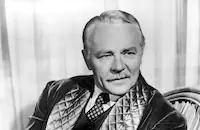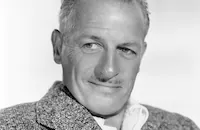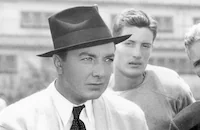No More Ladies

Brief Synopsis
Cast & Crew
Edward H. Griffith
Joan Crawford
Robert Montgomery
Charles Ruggles
Franchot Tone
Edna May Oliver
Film Details
Technical Specs

Synopsis
After waiting for over two hours for her beau, Sherry Warren, to show up for their dinner date, Marcia declares, as she has on many similar occasions, that Sherry is a heartbreaking scamp, and then turns in for the night. Marcia shares her elegant home with her grandmother, Fanny Townsend, who warns her about the rakish Sherry, yet both love him nevertheless. Also vying for Marcia's attentions is the naive and boring Oliver, who has become a seemingly permanent fixture in the Townsend household, and is usually found playing backgammon with Fanny. Later that night, Sherry shows up and, though offering no valid excuses for his tardiness, manages to charm Marcia into accompanying him to a nightclub. When Edgar Holden, Sherry's second cousin, spots the man-about-town, he jokingly offers to protect Marcia from his notorious abuses, and sends prizefighter James McIntyre Duffy over to rough him up. The two, however, turn out to be old chums, thus foiling Edgar's plan. Soon after, Jim Salston, whose wife Sherry had stolen from him years ago, approaches the playboy to complain that Caroline, another object of Sherry's affections, is upset because he passed her up on the dance floor. While Sherry makes amends with Caroline, Marcia leaves with Edgar for a drive in the park. Later, Sherry looks for Marcia at her home, finds that she is not there, and is warned by Fanny that if he is not careful he will meet with the same fate as the famed sea captain, Louis Casabianca, who died when he blew up his ship in order to prevent the enemy from capturing it. Marcia finally shows up, behaving as if nothing out of the ordinary has happened, and then shares a late night snack with Sherry, while they discuss the institution of marriage and all its attendant woes. Though they both agree that the odds against a succussful marriage are overwhelming, Sherry proposes marriage to the obstinate Marcia, and she accepts. When Fanny enters the room, she quickly realizes what has just transpired, and announces that Casabianca's ship has just sunk. While honeymooning at Whitehall Beach, Marcia finds Sherry flirting with Sally French and later admits that she is jealous. At Williams' Bar, Sherry steals Edgar's date, Theresa German, and fails to return to Marcia's that evening. Sherry calls her to tell her that he will not be coming home because Edgar has gotten ill and needs his help. Marcia knows Sherry is lying because Edgar is home with her, and realizes that her philandering husband has already ruined their marriage. Though a cad, Sherry later tells his wife the truth about the incident, admitting that he spent the night with Theresa, a "graduate of the old speakeasies." Insulted, Marcia slaps Sherry, but concedes that she knew about his flaws when she married him and predicts that it will happen again. Marcia takes her revenge on Sherry by throwing an impromptu party and inviting, unknown to her husband, a number of people who have been ill-treated by him. One of the first guests to arrive is Jim, who once tried to shoot Sherry, followed by Theresa and Lady Diana Knowlton, another lover Jim had lost to the playboy. Also present is Caroline. After Marcia announces that she and Jim are going for a drive, a quarrel ensues and Sherry promises to be unforgiving if she leaves. A game of charades affords Jim and Marcia an opportunity to escape, and when Sherry discovers the two have not returned the next morning, he makes preparations to leave for good. Fanny tries to stop him, and then Marcia pulls up just in time to save their marriage. After admitting that she felt bad about cheating on him because she truly loves him, all is forgiven and the two embrace.

Director
Edward H. Griffith
Cast

Joan Crawford

Robert Montgomery

Charles Ruggles

Franchot Tone

Edna May Oliver

Gail Patrick

Reginald Denny

Vivienne Osborne

Joan Burfield

Arthur Treacher
David Horsley
Jean Chatburn
William Wagner
Charles Coleman
Isabelle La More
Frank Dawson
E. J. Babille
Ed Hart
Charles O'malley
Tommy Tomlinson
Lew Harvey
David Thursby
Sherry Hall
Clem Beauchamp
Veda Buckland
Mabel Colcord

David O'brien

Walter Walker

Juliette Compton

Fred Kohler Jr.
Crew
Adrian
Nacio Herb Brown
Rachel Crothers
George Cukor
Edith Fitzgerald
Arthur Freed
Cedric Gibbons
Edward H. Griffith
Frank E. Hull
Horace Jackson
Oliver T. Marsh
George Oppenheimer
Sandy Roth
Donald Ogden Stewart
Irving G. Thalberg
Edward Ward
Edwin B. Willis
Joseph Wright

Photo Collections
Film Details
Technical Specs

Articles
No More Ladies
The comedy is based on a 1934 play that starred Lucille Watson and Melvyn Douglas and enjoyed 176 performances on Broadway. Rachel Crothers, who wrote the adapted screenplay, complained publicly about the way MGM had altered her work, and had her name removed from the film's credits. Donald Ogden Stewart, author of The Philadelphia Story, provided some of the sophisticated dialogue and shows up onscreen in an uncredited bit as a drunk.
When original director Edward H. Griffith became ill and could not complete the film, George Cukor took over but declined an onscreen credit. The strong supporting cast includes Edna May Oliver as a tipsy grandmother, Arthur Treacher as a stuffy Britisher who misuses American slang, Charlie Ruggles as an incorrigible drunk and Gail Patrick as a glamorous mantrap. Newcomer Joan Fontaine, billed as Joan Burfield, also has a small role.
According to Crawford biographer Bob Thomas, Cukor -- known for his expertise at bringing out the best in talented female stars -- had little respect for Crawford's studied style of acting. Working with her for the first time, he was quite brusque in his comments. After Crawford had delivered one long speech to Montgomery, the director said, "Very fine, Miss Crawford. Now, would you please repeat it? You remembered the words; now let's put some meaning into them." Surprisingly, Crawford submitted to his criticisms and strove to please him. When she had the chance to work with Cukor again in The Women (1939), she jumped at it. Cukor would also direct her in Susan and God (1940) and A Woman's Face (1941).
Crawford showed her kind side to studio newcomer Patrick, whom she had earlier helped by providing tips on makeup, clothes and posing for glamour portraits. It was Crawford who insisted that Patrick be allowed to test for No More Ladies, and she helped ensure the test's success by lending the younger actress the services of her makeup man and hairdresser, along with a becoming gown by studio designer Adrian. Crawford declined any thanks, saying, "There was a time when I would have been grateful if anyone had helped me."
Producer: Edward H. Griffith, Irving Thalberg (both uncredited)
Director: Edward H. Griffith, George Cukor (uncredited)
Screenplay: Donald Ogden Stewart, Horace Jackson, Rachel Crothers (uncredited), Edith Fitzgerald (uncredited), George Oppenheimer (uncredited), from play by A.E. Thomas
Cinematography: Oliver T. Marsh
Art Direction: Cedric Gibbons
Original Music: Edward Ward
Editing: Frank E. Hull
Costume Design: Adrian
Cast: Joan Crawford (Marcia Townsend Warren), Robert Montgomery (Sheridan "Sherry" Warren), Franchot Tone (Jim "Jimsy Boysie" Salston), Charles Ruggles (Edgar Holden), Edna May Oliver (Mrs. Fanny "Grandma" Townsend), Gail Patrick (Therese Germane), Reginald Denny (Oliver Allen), Arthur Treacher (Lord "Ducky" Knowleton), Joan Fontaine (Caroline "Carrie" Rumsey).
BW-81m.
by Roger Fristoe

No More Ladies
Quotes
Trivia
The play opened in New York City, New York, USA on 23 January 1934 and had 176 performances. In the cast were Melvyn Douglas and Lucile Watson.
Rachel Crothers, who adapted the play for the screen, complained bitterly in an article about her work being butchered by producers and directors. M-G-M removed her credit from the film at her request.
George Cukor took over as director when Edward H. Griffith fell ill, but refused an onscreen co-director credit.
Eddie Hart (Taxi Driver), Sherry Hall (Captain), Walter Walker and Fred Kohler Jr. are listed in studio records and/or casting call lists for parts in this movie, but were not seen in the print.
Notes
According to a Hollywood Reporter pre-production news item, actors Ruth Weston and Lucile Watson, who starred in the stage production of No More Ladies, were initially announced as stars of this film. Another pre-production news item notes that an aquatic stage, with a pool serviced by hydraulic pumps, was built for the film, and was to be the first of its kind to be used in any picture. Although a pre-release Hollywood Reporter news item indicated that the film would mark the last screen appearance of screenwriter, playwright and novelist Donald Ogden Stewart, who was set for a bit role, his appearance in the released film has not been confirmed. Hollywood Reporter production charts list actress Louise Henry in the cast, but her appearance in the released film has also not been confirmed. A contemporary New York Times article notes that a dispute arose between M-G-M and screen writer Rachel Crothers, the veteran Broadway playwright, whose first screen writing job was that of adapting A. E. Thomas' play for the screen. In the article, Crothers lambasts the Hollywood system and complains that the producers and directors were given "every right to pull it [the story] to pieces and destroy it." Following the completion of her assignment, Crothers maintained that other writers had re-written the story so many times that she could no longer recognize her work. At her request, M-G-M removed Crothers' credit from the film, and she went on to work with Sam Goldwyn, who, she claimed, was the only producer in Hollywood who treated writers with respect. Although most contemporary sources credit Irving G. Thalberg as the producer of No More Ladies, Variety lists Edward H. Griffith. According to a Hollywood Reporter pre-release news item, George Cukor took over direction of the picture when Griffith fell ill, but refused a co-direction credit. The film marked the screen debut of Joan Fontaine, who was credited as Joan Burfield. An unidentified source in the file on the film at the AMPAS Library credits Jack D. Moore and Henry Grace with the set decoration.















